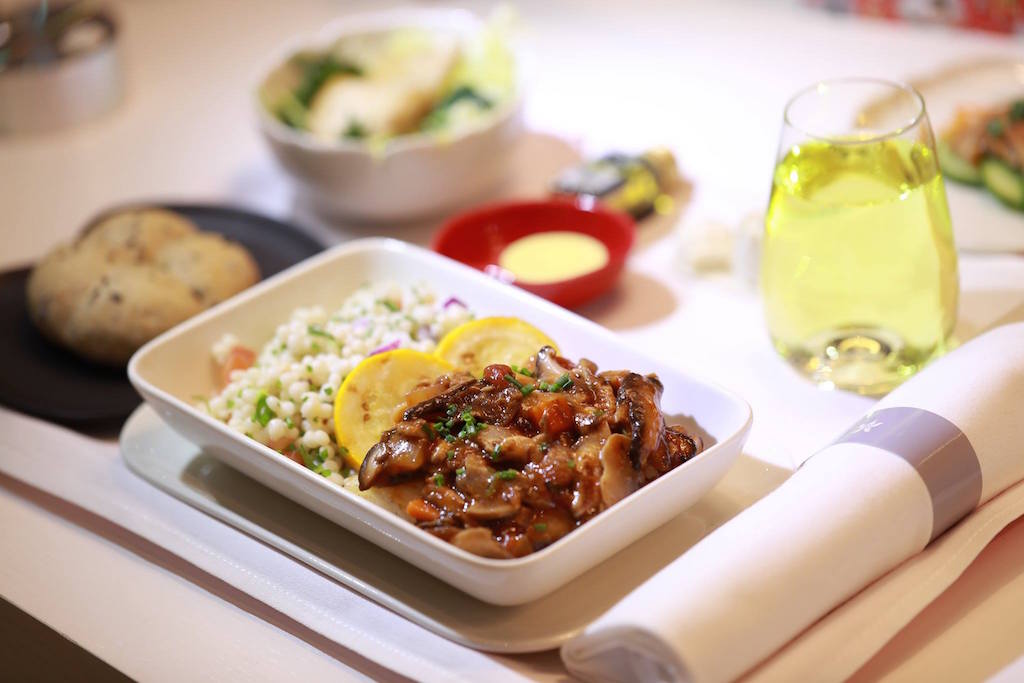Longer Flights Have Hong Kong Airlines Rethinking Customer Experience

Skift Take
When Hong Kong Airlines re-started flying routes two years ago, it could have completely re-thought the passenger experience, perhaps straying from service norms set decades ago by legacy carriers.
But the airline, which had flown regional routes in Asia for a decade, and in 2012 briefly flew to Europe, chose not to, preferring to give passengers what they have come to expect. The service on Hong Kong Airlines might be a little more informal than on Cathay Pacific, its main competitor, but the basic gist is the same. Hong Kong Airlines executives figure passengers have basic expectations from an airline, and they suspect customers on their longest flights to Vancouver, Los Angeles and San Francisco want what they know.
For the latest installment of our airline insiders series, we've interviewed Chris Birt, general manager for service delivery at Hong Kong Airlines. Birt joined the airline in 2015, after stints at TUI Airlines Group and Virgin Atlantic.
We spoke to Birt about the challenges of launching new long-haul service, and why some questions — like what meals to serve at what times — continue to vex the industry.
Note: This interview has been edited for length and clarity.
Skift: Let's start with a simple question. What do you do?
Birt: My role is quite broad. It covers everything from inflight to catering, in flight entertainment, the crew, the hard product, and the soft product. It leaks into some of the ground experience and the lounge experience here in Hong Kong as well, but predominantly my focus is the onboard experience for the customer.
Skift: Your airline is new to long haul. Is it tough to introduce international service standards at what was until recently a regional carrier?
Birt: We have a great team of crew with some great experience, but transforming from that regional carrier to long haul does make you really rethink what you do. In the past, Hong Kong Airlines would predominantly carry local Hong Kong customers, mainland Chinese customers and those in the Asian region. Now we're now seeing a much broader mix of customers from the U.S., from Europe, and that makes you rethink that the expectations from a cultural point of view.
Skift: Do customers from different regions have different expectations?
Birt: I think everybody has the same basic expectations — safety, on-time, a good schedule, a good product, consistency. But when you look at the finer aspects of both the hard product, the soft product, and the crew service, I think yes, we're definitely seeing customers from different parts of the world have different expectations.
One example that we've really been talking to our crew about is how you engage with customers. A lot of Asian customers, on the whole —and I'm speaking very broadly here — they get on board and they don't expect quite so much. I think more Western customers expect a different level of engagement with the crew, and it's really about making sure your crew are aware of that.
Also, I'm certainly not talking about Hong Kong customers here, but from some Asian countries, it is apparent that the U.S. and European traveler is probably more experienced, has probably experienced other airlines, and has probably got a very different expectation of air travel than maybe somebody who hasn't traveled quite so much.
Skift: Is that a nice way of saying that U.S. customers are needier?
Birt: I don't think it's more needs. It's just understanding that even the nuances and the smaller aspects of expectation and delivery are quite different. I look at everything from the way we would serve wine, to what stage in the meal you would offer tea and coffee. It goes down to that level. It's not necessarily that a U.S. or European customer is more needy. It's just that their expectations are maybe slightly different.
We recently had an online flight review that commented on exactly the same points. Going into L.A., we serve breakfast because we land at 8:15 in the morning. [The customer said,] 'I was served my breakfast, but it wasn't until the end of breakfast that I was offered tea or coffee.' The majority of your western customers would expect their tea and coffee with their breakfast, and particularly a European or an American customer.
It goes down to that really fine detail of how you might offer something. You've really got to ensure your crew are aware about it, because culturally, in their own experience when they have predominantly been caring for Asian customers, that expectation —something as basic as when we serve tea or coffee — might be completely different.
Skift: Most airlines take two hours to serve a meal in business and first class. Does it really take that long? Or are airlines stretching it to make it more of an experience?
Birt: It's a bit of all of that. I think that it does take that long when you're serving a full business class cabin of 33 customers, once you've taken off the seatbelt signs, the crew are released and then the service starts. But it can be much quicker depending on how much of the experience the customer wants to have. On a day flight, I think customers are much more willing to take that time, especially on a long flight, 15 hours from L.A. back to Hong Kong. It's how you adapt that service to maybe a very late departure where a customer's priority is sleeping or if you've got a much quicker flight.
I think that you certainly feel it as a customer if you are rushed. If you want that service a bit quicker, it's not impossible to have that. For our crews, it's about reading the customer and trying to understand, and talking to them about what their priority is.
Skift: Do millennials want anything different from a business class experience?
Birt: Everybody wants the same basics: A good consistent product, good friendly, consistent service from the crew. But the millennial is looking for more technology in terms of wifi. They might be looking for a different experience with the entertainment system. But I think that generally it doesn't matter what your age, or what your level of experience traveling, you've got the same basic level of expectation.
Speaking very broadly, it really just depends on your reason for travel. If you're traveling for leisure, even in a business cabin, your expectations might be different. If you're there to work, you want to get on and work, and you want the service to be a little less intrusive and a little bit quicker and you want to have the ability to work easily with the technology around you. I don't believe it's an age question. I think it's more of a reason for travel question.
Skift: You are not the first airline executive to tell me consistency is vital. Is consistency sometimes more important than luxury?
Birt: Absolutely. The consistency is a challenge. It has been in the four carriers that I've worked for. It's a challenge for every airline and everybody in my role that I've ever spoken to. It doesn't matter whether you're one of the Middle East airlines that can generally do it really well, or one of the growing, up and coming, mainline Chinese airlines. Consistency is the most talked about topic, because customers want consistency. At the same time, they don't want robotic service, so it's about getting that balance right.
Skift: Airlines often serve breakfast at the end of overnight long-haul flights. They'll do it even if the plane lands at 4 p.m. Why?
Birt: A lot of it is historical. A lot of it is what the customer expects. But what you're trying to do is match the time zone, as best you can, to the customer's body clock. You're trying to get the customer into the time zone they're arriving at.
It's difficult when you've got a very long overnight flight that lands as the customer is waking up, because that's the time zone they left, but the local time is afternoon or tea time. That's sometimes why you may be eating breakfast at, locally, a very strange time. [Eating breakfast] feels right for your body, but it doesn't necessarily help you get into local time.
We have a flight that landed at the sort of time you were talking about, sort of mid-afternoon, and although it was an overnight flight and most of the customers were waking up, we did actually try to offer more of a [lunch], or a hot meal service, and the feedback we got was actually the customers were expecting breakfast.
Skift: Did you switch to breakfast?
Birt: We did, because that what the customers told us they wanted. That's what's important. You will never get it right for 100 percent of your customers. It depends on how much sleep they've had, and what time zone they've decided to stay in or change to.
It's not an exact science, and I'm not saying we always get it right. But it's about listening to the customer, and it's also about trying to have a bit of variety. If we had a customer that really didn't want breakfast at breakfast time and we had an alternative, which on a long fight you would have, we would be very happy to serve them a steak, if that's what they really wanted at that time in the flight.
Skift: Here's another fun food question for you. Airlines have been flying for 90 years, give or take. Is it that hard to guess how many passengers will want each meal to so can properly provision flights?
Birt: Yes, absolutely.
Skift: Why?
Birt: You can never predict what the customer's going to want. When you launch a new menu or a new selection of dishes, you can guess, but you really don't know which are going to be the most popular dishes. The last thing you want to do — and it doesn't matter if its business class, or economy class — is to tell somebody they can't have what they want. But inevitably it happens, particularly at the beginning of a new menu selection or menu cycle. You've got to rely very much on the reporting of your crew to tell you, did you get it right? Did you get your ration of chicken and fish correct? If you didn't, what would've ensured that every customer got what they wanted? You spend a good amount of your time with data looking at and amending that ratio.
The majority of the time, everybody gets what they want. And all airlines are trying to balance customer choice with wastage, and you don't want excessive wastage from a cost or an environmental point of view.
It's actually much harder in economy class. In business class you typically carry more meals than you actually have customers, so that you can offer the choice.




